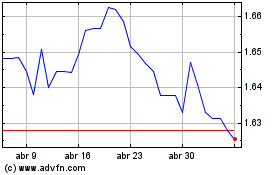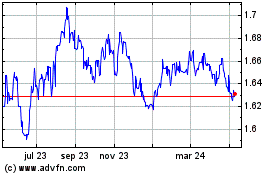Euro Falls As Draghi Says Sustained Increase In Inflation Needed To End QE
14 Marzo 2018 - 1:17AM
RTTF2
The euro dropped against its major counterparts in the European
session on Wednesday, after the European Central Bank President
Mario Draghi cautioned that there should be more evidence that
inflation is moving towards to the goal to bringing net asset
purchases to a gradual end.
Speaking at the annual ECB watchers conference in Frankfurt,
Draghi said that inflation has been converging towards the aim over
the medium term, but the policy makers are waiting for further
evidence that inflation dynamics are moving in the right
direction.
"There is a very clear condition for us to bring net asset
purchases to an end: we need to see a sustained adjustment in the
path of inflation towards our aim," he told.
"So monetary policy will remain patient, persistent and
prudent," he added.
Data from Eurostat showed that Eurozone industrial production
declined for the first time in four months in January.
Industrial production decreased 1 percent month-on-month in
January, in contrast to December's 0.4 percent rise. This was the
first fall since last September and also bigger than the forecast
of 0.4 percent drop.
The currency traded mixed against its major rivals in the Asian
session. While it rose against the yen and the greenback, it held
steady against the pound and the franc.
The single currency retreated to 1.2364 against the greenback,
from a 6-day high of 1.2413 hit at 1:30 am ET. On the downside,
1.21 is seen as the next possible support level for the euro.
The euro eased back to 0.8865 against the pound, after having
advanced to 0.8879 at 4:00 am ET. The euro is seen finding support
around the 0.87 region.
The 19-nation currency edged down to 131.73 against the yen, off
its early high of 132.28. Next key support for the euro is likely
seen around the 128.00 region.
Minutes from the Bank of Japan's January 22-23 meeting showed
that members of the monetary policy board said that the country's
economic growth is continuing at a satisfactory rate.
The members added that exports were on a rising trend, which was
helping to fuel the recovery.
The euro reversed from its early highs of 1.5783 against the
aussie, 1.6926 against the kiwi and 1.6068 against the loonie,
dropping to 1.5673, 1.6872 and 1.6009, respectively. The next
possible support for the euro is seen around 1.55 against the
aussie, 1.68 against the kiwi and 1.56 against the loonie.
Following a 4-day high of 1.1709 hit at 4:00 am ET, the euro
pulled back to 1.1692 against the Swiss currency. The euro is
poised to find support around the 1.14 level.
Looking ahead, U.S. retail sales and producer prices for
February, as well as business inventories for January are scheduled
for release in the New York session.
Euro vs AUD (FX:EURAUD)
Gráfica de Divisa
De Mar 2024 a Abr 2024

Euro vs AUD (FX:EURAUD)
Gráfica de Divisa
De Abr 2023 a Abr 2024
